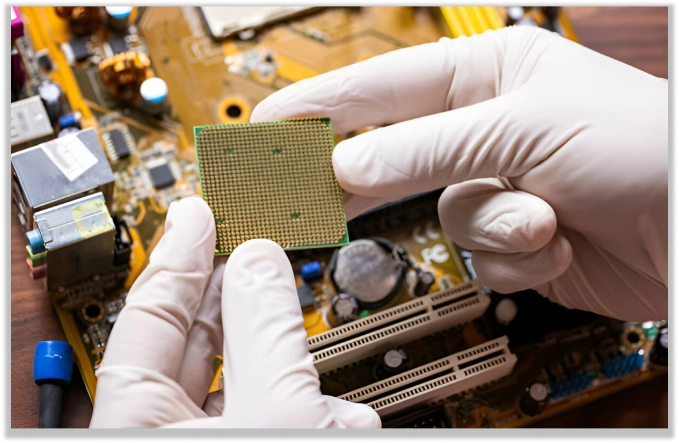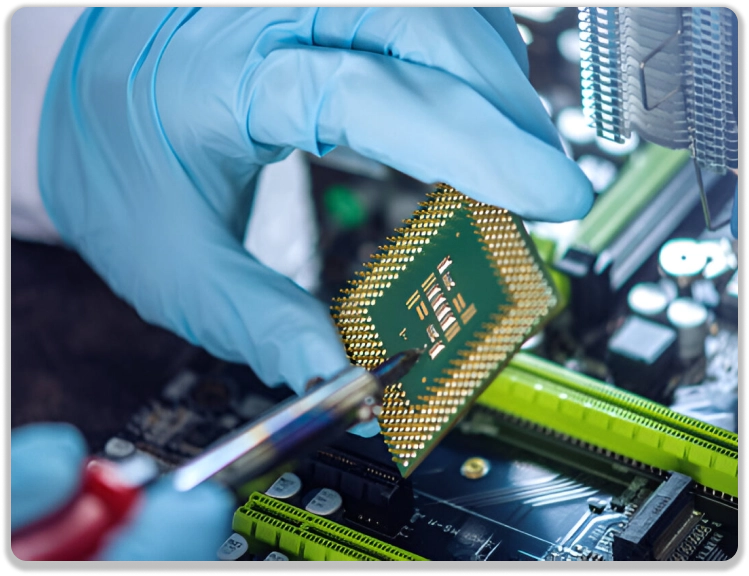Semiconductor
Manufacturing
From Silicon to Solutions: Excellence in Semiconductor Manufacturing

Localized Production & Risk Mitigation
High tech companies lost $275 billion in revenue due to supply chain disruptions in 2021–2022, which is why governments and companies alike have come to agree on one main objective: offshoring to reduce the risks associated with producing the majority of the world’s semiconductor chips in a small number of locations. The average amount spent by high-tech companies in 2023 to digitize, automate, and move their production and supply facilities was $1.1 billion; by 2026, this amount is projected to rise to $3 billion. In fact, by 2026, 76% of high-tech companies—a significant increase from 42% today—plan to produce and sell the majority of their products in the same location.

Challenges & Success Strategies
In the United States, more than 60 new or expanded production sites have already been announced. The companies involved are very positive about their future and plan to be prepared for the predicted increase in chip demand in 2024. Executives are well aware of the significant obstacles they must overcome in order to succeed, though. They are aware that the agenda they are carrying out will require most of them to step considerably outside of their strategic comfort zones. Accenture has highlighted four actions that companies may take to improve their chances of success as they accelerate their efforts to develop and run onshore fabrication plants (fabs). These steps are based on feedback from executives in the semiconductor industry and continuing quantitative research.
Deep Tech suggest following steps to go around the existing terrain:

Establish internal capacity to participate in public-private partnerships:
Just the US government committed to providing the semiconductor industry with $52 billion in manufacturing funding and research, in addition to a 25% investment tax credit. How business leaders will be able to obtain some of this government cash is the challenge. High tech companies should be proactive in creating a team responsible for interacting with government authorities and overseeing the grant process in order to increase the likelihood of fulfilling the requirements set forth by the federal government and state governments. This group should become knowledgeable about best practices for public-private partnerships, assist in managing government requests, and navigate approaching deadlines.
Elevating ecosystem alliances is another area high tech businesses should concentrate on to encourage deeper engagement with the public sector. Emphasizing the distinct function that every stakeholder plays in creating new factories aids government partners in transitioning from lenders to industry stewards who collaborate with an ecosystem.

Reevaluate your talent tactics:
Skill set is just as important as the physical architecture of the fab, yet the high tech sector, like many others, is severely lacking in STEM skills. Businesses should concentrate on giving current employees the opportunity to acquire in-demand skills and transition between tasks in order to close this gap. Engineering talent and linked technologies have a high probability of transferability, which can reveal untapped talent pools and close skills gaps. Increasing the pool of talent is an additional venue. For instance, creating official outreach initiatives from urban to rural areas is a terrific method to draw in workers from diverse backgrounds and increase company understanding outside of the conventional talent pool. The government’s increasing emphasis on diversity presents an opportunity to expand federal funding and public-private partnerships, which may be used to support workforce initiatives aimed at identifying, attracting, and retaining diverse talent.
Lastly, by automating work where feasible, artificial intelligence can free up time to fill more strategic and time-sensitive positions. To manage fabs as efficiently as possible, the strategy should, however, involve more than just automating to produce operational efficiencies. Instead, it should concentrate on acquiring the proper personnel to take advantage of emerging technology.

Take the initiative to learn about new technology and security:
Every year, the number of stakeholders involved in bringing a solution to market rises, and manufacturing processes get more intricate. This implies that security is more crucial than ever, especially in relation to supply chain security and developing technologies. Any company that takes security seriously needs to make sure that security is ingrained across the whole enterprise. Define and codify security-related duties and responsibilities, and create mandatory, regular, formal training for all personnel, without exception.
In a same vein, security should guide the design and construction of fabs. As soon as feasible, begin by determining the technologies and techniques required to safeguard data, technology infrastructure, and architecture. The government can also help in this regard. The International Technology Security and Innovation Fund of the US State Department provides $500 million to support business partners’ defense capacities through cybersecurity technologies, enabling them to investigate and protect semiconductor manufacture.

Evaluate ROI projections again:
The project’s timeline from planning to launch is getting shorter as new partners, change management, and talent increase its complexity. These elements affect estimated ROI, raise predicted expenses, and reduce available time. Adapting appropriately will help organizations avoid being caught off guard. Information sharing and the use of financial incentives to fortify industry ecosystems are two effective strategies for preventing unpleasant ROI surprises. Make the players in the local supply chain assume new roles and adjust accordingly. To lower risk and boost bargaining power, try interacting with partners in novel ways and thinking about new financing arrangements with OEMs and suppliers. While information-sharing agreements with suppliers and consumers provide a better knowledge of the complexity they encounter and offer predictability to production, long-term supply agreements can assist stabilize market swings. It takes time and money to build capacity, so be sure to communicate the project’s long-term worth to the government and investors. Such initiatives necessitate a mental shift, emphasizing the development of long-term capacities over the satisfaction of immediate demands. Collaborate closely with finance and operations to offer precise direction on value created for all stakeholders, both now and in the future, by utilizing AI and predictive analytics.

